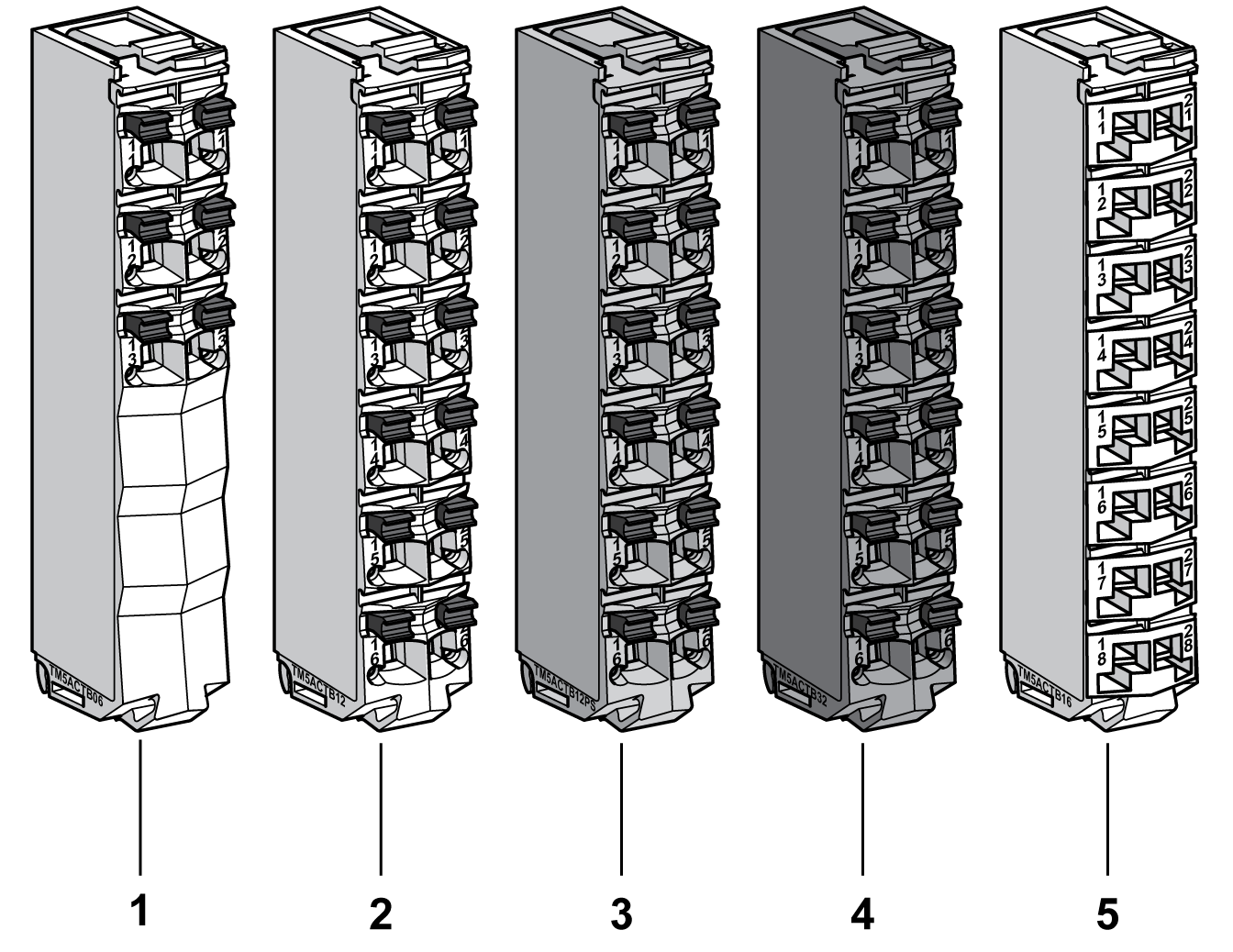TM5 System Terminal Blocks
Overview
The main features of the terminal blocks are:
-
Tool-free wiring with spring clamp push-in technology
-
Simple push-button wire release
-
Ability to label each terminal
-
Plain text labeling also possible
-
Test access for standard probes
-
Can be custom-coded
The following figure shows the TM5 System terminal blocks:

|
Number |
Reference |
Description |
Color |
|---|---|---|---|
|
1 |
TM5ACTB06 |
6-pin terminal block designed for 24 Vdc I/O modules and TM5SBET1 Transmitter module. |
White |
|
2 |
TM5ACTB12 |
12-pin terminal block designed for 24 Vdc I/O modules, Common Distribution Modules (CDM) and Transmitter modules. |
White |
|
3 |
TM5ACTB12PS |
12-pin terminal block designed for 24 Vdc Power Distribution Modules (PDM), 24 Vdc Interface Power distribution Module (IPDM) and Receiver module. |
Gray |
|
4 |
TM5ACTB32 |
12-pin terminal block designed for AC and I/O relays modules. |
Black |
|
5 |
TM5ACTB16 |
16-pin terminal block designed for 24 Vdc I/O modules, Common Distribution Modules (CDM) and Transmitter modules. |
White |
A slice must only be composed of a single color. For example, a gray bus base should only be assembled with a gray electronic module and a gray terminal block. However, color alone is not sufficient for compatibility; always confirm that functionality of slice components matches as well.
| DANGER | |
|---|---|
General Characteristics
| DANGER | |
|---|---|
| WARNING | |
|---|---|
| WARNING | |
|---|---|
The following table shows the technical data for TM5 System terminal blocks, see also environmental characteristics:
|
General Characteristics |
||||||||
|---|---|---|---|---|---|---|---|---|
|
Type of terminal |
Spring-clamp push-in terminal |
|||||||
|
Contact resistance |
≤ 5 mΩ |
|||||||
|
Maximum voltage1 |
300 V |
|||||||
|
Current1 |
10 A maximum per connector |
|||||||
|
Weight |
TM5ACTB06 |
16 g (0.6 oz) |
||||||
|
TM5ACTB12 TM5ACTB12PS TM5ACTB16 TM5ACTB32 |
20 g (0.7 oz) |
|||||||
|
Connection cross section: |
||||||||
|
Solid wire line |
0.08 mm²...2.5 mm² (AWG 28...14) or 0.08 mm²...1.5 mm² (AWG 28...16)3 |
|||||||
|
Fine wire line |
0.25 mm²...2.5 mm² (AWG 24...14) or 0.25 mm²...1.5 mm² (AWG 24...16)3 |
|||||||
|
With wire cable end |
0.25 mm²...1.5 mm² (AWG 24...16) or 0.25 mm²...0.75 mm² (AWG 24...20)3 |
|||||||
|
With double wire cable end2 |
2 x 0.25...2 x 0.75 mm² (AWG 2 x 24...2 x 18) |
|||||||
|
Wire |
Follow the wiring rules. |
|||||||
|
Note:
|
||||||||
| DANGER | |
|---|---|
Maximum Insertion/Removal Cycles
The TM5 System bus bases are designed to withstand up to 50 electronic module insertion/removal cycles.